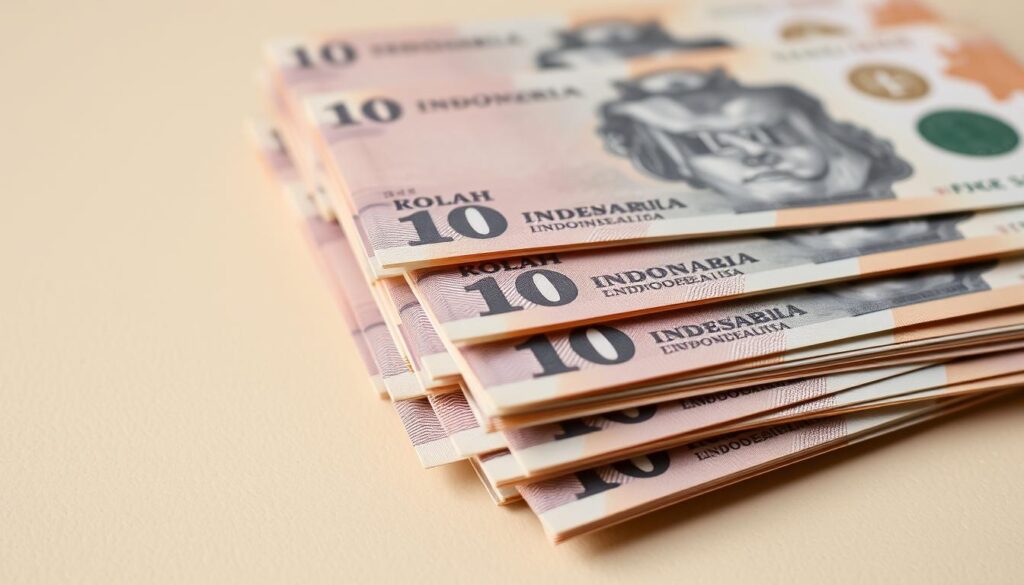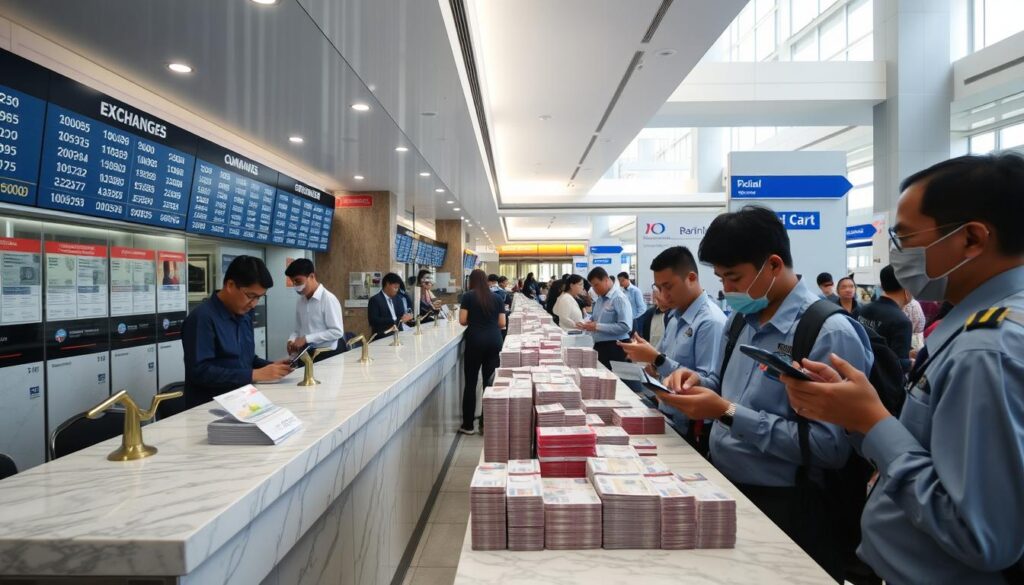
The Indonesian economy heavily relies on its official currency, the IDR. With over 270 million people, Indonesia is the largest economy in Southeast Asia. Its currency is key for trade and commerce.
Bank Indonesia, the country’s central bank, issues and regulates the IDR. As the sole issuer, Bank Indonesia makes sure the IDR is accepted everywhere. This includes big cities like Jakarta and rural areas.
Knowing about the IDR is vital for anyone planning to visit or invest in Indonesia. The IDR’s unique features make it a crucial part of Indonesia’s economy.
Key Takeaways
- The IDR is the official currency of Indonesia.
- Bank Indonesia is responsible for issuing and regulating the IDR.
- The IDR is widely accepted throughout Indonesia.
- Understanding the IDR is crucial for travelers and investors.
- The IDR plays a vital role in Indonesia’s economy.
Understanding the Indonesian Rupiah (IDR)
The Indonesian Rupiah was first introduced in 1946. It has seen many changes since then. These changes were due to the country’s economic and political shifts.
History and Evolution of the Indonesian Rupiah
The Rupiah started when Indonesia was gaining independence. At first, it was tied to the Dutch guilder. This showed the country’s ties to the Netherlands.
Over time, the Rupiah has changed. New banknotes and coins were added to fight inflation and improve security.
A big step was the 1990s when new banknotes and coins were introduced. They had better security to stop fake money. This was to make the currency more stable and trusted again.
The Role of Bank Indonesia in Currency Management
Bank Indonesia is key in managing the Rupiah. It aims to keep the currency stable, control inflation, and protect the financial system.
Bank Indonesia issues money, controls the money supply, and watches over banks. It also fights counterfeiting with advanced security in banknotes and coins.
Keeping the economy stable is crucial for Bank Indonesia. This stability affects the Rupiah’s value. By managing money and keeping the financial system stable, the bank protects the currency’s worth at home and abroad.
Indonesian Rupiah Money: Denominations and Features
The Indonesian Rupiah comes in various banknotes and coins. They show important national figures and landmarks. Bank Indonesia, the central bank, makes sure the money is stable and safe.
Current IDR Banknotes in Circulation
IDR banknotes range from Rp1,000 to Rp100,000. Each has its own design and security to stop fake money. For example, the Rp100,000 note has Sukarno-Hatta’s portrait and advanced security like watermarks.
The notes also show Indonesian landmarks and symbols. This boosts national pride. They update designs to add new security features and honor important events or people.
Indonesian Rupiah Coins and Their Specifications
Coins range from Rp50 to Rp1,000. They’re made from metals like nickel, copper, and aluminum. Each coin reflects Indonesian culture and heritage.
The Rp1,000 coin, for instance, is a mix of metals. It has a national monument image. Coins are made to last, perfect for daily use.
In summary, Indonesian Rupiah banknotes and coins focus on security, durability, and national pride. Knowing about the different denominations helps locals and visitors understand the Indonesian economy better.
The IDR Symbol and Currency Code
The Indonesian Rupiah is the official currency of Indonesia. It has a unique symbol and code known worldwide. The symbol is “Rp” and the code is “IDR.”
Official Representation of the Indonesian Rupiah
In Indonesia, “Rp” is used to show prices and financial deals. It stands for “Rupiah,” the local name for the currency. You see “Rp” everywhere, from markets to banks.
The “IDR” code is used globally for the Indonesian Rupiah. It’s part of the ISO 4217 standard for currency codes. This code helps identify the Indonesian Rupiah in international dealings.
International Recognition and Usage
Though “Rp” is mainly used in Indonesia, “IDR” is known worldwide. It’s key for telling the Indonesian Rupiah apart from other currencies. This is important in international transactions, travel, and finance.
The IDR is also found in big currency exchange platforms and financial databases. This makes it easier for businesses and people to deal with IDR in global trade and finance.
Current Exchange Rates and Value of Indonesian Rupiah
Knowing the current IDR exchange rate is key for understanding Indonesia’s economy. It helps in making smart financial choices. The IDR to USD rate is especially important because the USD is a global reserve currency.
IDR to USD Conversion Rates
The IDR to USD rate changes based on many factors. These include inflation, interest rates, and Indonesia’s economic performance. Recently, the rate has moved due to global market shifts and economic changes.
| Date | IDR/USD Rate | Change |
|---|---|---|
| 2023-01-01 | 14,500 | – |
| 2023-02-01 | 14,700 | +200 |
| 2023-03-01 | 14,300 | -400 |
Factors Affecting the Rupiah’s Value
Many things influence the Indonesian Rupiah’s value. These include economic indicators, global market trends, and political stability. The GDP growth rate, inflation, and unemployment rate are key economic indicators.
Global market trends also play a role. For example, rising oil prices can increase Indonesia’s import costs. This can weaken the Rupiah.
Political stability is crucial too. A stable political scene attracts foreign investment, making the currency stronger. But, political unrest can make the Rupiah value drop.
To keep up with IDR exchange rate changes, check reliable financial news and currency exchange sites.
Indonesian Rupiah in the Foreign Exchange Market
The value of the Indonesian Rupiah is greatly affected by the foreign exchange market. As a key currency in emerging markets, the IDR faces many global economic factors. These factors and investor feelings play a big role in its value.
Rupiah Trading Patterns and Liquidity
The trading patterns of the Indonesian Rupiah are shaped by global economic conditions and commodity prices. Also, decisions made by the central bank are important. The IDR’s liquidity in the market is key for its stability and appeal to investors.
Several factors impact IDR liquidity:
- Economic indicators like GDP growth and inflation rates
- Decisions by Bank Indonesia on monetary policy
- Prices of global commodities, especially crude oil
The IDR’s liquidity is also affected by its role in major currency pairs. Its trading volume on the foreign exchange market also matters.
IDR Position Among Asian Currencies
The Indonesian Rupiah is a major currency in Asia, alongside the Chinese Yuan, Japanese Yen, and Singapore Dollar. Its standing among Asian currencies is influenced by several factors.
The IDR’s position is shaped by:
- Economic performance and growth prospects
- Trade relationships and export-import dynamics
- Investor confidence and market sentiment
Market observers keep a close eye on the IDR’s performance. They compare it to other Asian currencies to understand regional economic trends and investment chances.
Currency Exchange Options for Travelers to Indonesia

Traveling to Indonesia means you need to know where to exchange your money. You can do this at airports, banks, and authorized money changers.
Best Places to Exchange Currency in Indonesia
Indonesia has many places to exchange currency. Authorized money changers and local banks often give good rates. But, avoid airports and tourist spots for better rates.
Here are some top places to exchange currency:
- Local banks: They usually offer better rates than airports or tourist areas.
- Authorized money changers: These are licensed operators that provide competitive rates.
- Currency exchange counters at shopping malls: Some malls have dedicated currency exchange counters that offer good rates.
Tips for Getting the Best Exchange Rates
To get the best rates, compare different exchange providers. Use a currency converter app or website to help. Exchanging more money can also save you on fees.
Some places in Indonesia accept foreign currencies, especially USD. But, the Indonesian Rupiah is the main currency. An Indonesia money converter can show you the value of your money in IDR.
For the latest Indonesian Rupiah to USD rates, check online converters or financial news sites. This helps plan your trip and manage your money well.
Digital Transactions and the Indonesian Rupiah
Digital transactions have changed how we handle money in Indonesia. The Indonesian Rupiah is key in this shift. Online banking and payments are now common, reshaping how we do business.
Online Banking and Payment Systems in Indonesia
Online banking and digital payments are booming in Indonesia. Key developments include:
- Expansion of digital banking services by major Indonesian banks.
- Introduction of innovative payment systems, such as QR code payments.
- Increased use of e-wallets and digital payment platforms.
Cryptocurrency Adoption and Regulation
Cryptocurrency use is growing in Indonesia. The government has set rules to oversee its use. Cryptocurrency exchanges must follow anti-money laundering laws to keep transactions safe.
The government and banks are teaming up to make digital transactions better. They aim to improve security and efficiency.
Economic Factors Influencing the Indonesian Rupiah

The value of the Indonesian Rupiah is shaped by many economic factors. It’s important for investors, traders, and those interested in Indonesia’s economy to understand these factors.
Indonesia’s Economic Indicators and Currency Stability
Indonesia’s economic signs, like inflation rates, GDP growth, and trade balances, are key to the Rupiah’s stability. A stable inflation rate and steady GDP growth are good for the currency.
- Inflation Rate: High inflation can lower the Rupiah’s value.
- GDP Growth: Strong GDP growth shows a healthy economy, which can strengthen the Rupiah.
- Trade Balance: A trade surplus can increase foreign currency reserves, helping the Rupiah.
Government Policies Affecting the Rupiah
Government policies, including monetary and fiscal ones, greatly affect the Rupiah’s value. The central bank, Bank Indonesia, sets monetary policies that can either help or hurt the currency.
- Monetary Policy: Changing interest rates can draw or push away foreign investment, affecting the Rupiah.
- Fiscal Policy: Government spending and taxes can influence economic growth and the Rupiah’s stability.
For example, during tough times, the government might use more spending to boost growth. This can change the Rupiah’s value.
Knowing these economic factors and government policies is key to guessing the Rupiah’s future. By studying these, investors and traders can make better choices in Indonesia’s market.
Currency Conversion Tools and Resources
Travelers and investors need reliable tools to handle the Indonesian Rupiah. These tools show the IDR’s value against other currencies. They help make smart financial choices.
Online Currency Converters for IDR
Online currency converters are key for changing Indonesian Rupiah to other currencies. You can find them on many financial and currency exchange sites.
- XE Currency Converter: Known for its accuracy and real-time exchange rates.
- Google Currency Converter: A quick and easy-to-use tool for converting currencies.
- OANDA Currency Converter: Offers historical exchange rates in addition to current rates.
These online tools are great for travelers and investors. They keep you updated on the IDR’s value against the US Dollar or Euro.
Mobile Apps for Tracking Rupiah Exchange Rates
Mobile apps make it easy to track the Indonesian Rupiah’s exchange rates anywhere. Some top picks are:
- Currency Converter Plus: Offers a clean interface and supports a wide range of currencies.
- XE Currency: Provides real-time exchange rates and historical data.
- OFX: Allows users to track exchange rates and even conduct currency exchanges.
These apps are easy to use. They help anyone keep an eye on the IDR’s exchange rates and make smart choices.
Practical Tips for Handling Indonesian Currency
Handling Indonesian Rupiah well needs knowledge and cultural awareness. When you travel to or work in Indonesia, knowing about the Rupiah is key. It makes your financial dealings smoother.
Identifying Authentic Indonesian Banknotes
To spot fake banknotes, learn the security features of Indonesian Rupiah. The Bank Indonesia has added advanced security to the currency. These include:
- Watermarks: Real banknotes show watermarks when light is shone through.
- Holograms: The Rupiah has holograms that show the bill’s value.
- Security Threads: These threads glow under ultraviolet light.
Bank Indonesia says checking these features is important. It helps ensure the banknotes you get are real. “The security features protect everyone from fake money,” a spokesperson explains.
Cultural Aspects of Money Handling in Indonesia
In Indonesia, money handling is more than just a transaction. It involves cultural norms. For example, giving or taking money with both hands shows respect. This is a big part of Indonesian culture, where using one hand is seen as rude.
“Using both hands to give or receive something, including money, is a gesture of respect and gratitude in Indonesian culture.”
Also, how you handle money in public shows your cultural awareness. Being aware of these customs can improve your interactions with locals. It makes your experience better.
In summary, handling Indonesian Rupiah with care and understanding its cultural context improves your financial dealings in Indonesia.
Conclusion: The Future of the Indonesian Rupiah
The Indonesian Rupiah is key to the country’s economy. Its future depends on economic policies, global trends, and political stability.
The Rupiah’s value changes due to Indonesia’s economic health, government actions, and its role in the foreign exchange market.
The Rupiah’s future looks promising. Indonesia aims to keep its economy stable, control inflation, and draw in foreign investors.
Thanks to Bank Indonesia’s smart currency management and the government’s careful economic plans, the Rupiah is set to stay strong and reliable.
As the world economy shifts, knowing how the Indonesian Rupiah works is vital. This knowledge helps investors, travelers, and businesses in Indonesia.
FAQ
What is the Indonesian Rupiah, and what is its significance?
The Indonesian Rupiah (IDR) is Indonesia’s official currency. It’s key to the country’s economy. It’s used for all money dealings in Indonesia and is issued by Bank Indonesia.
How is the Indonesian Rupiah regulated?
Bank Indonesia controls the Indonesian Rupiah. They keep the currency stable, stop counterfeiting, and manage money supply.
What are the different denominations of Indonesian Rupiah banknotes and coins?
Indonesian Rupiah has various banknotes and coins. Banknotes range from Rp1,000 to Rp100,000. Coins are in denominations of Rp100, Rp200, Rp500, and Rp1,000.
What is the official symbol for the Indonesian Rupiah?
The official symbol for the Indonesian Rupiah is “Rp.” It’s recognized and used both at home and abroad.
How can I exchange my currency for Indonesian Rupiah?
You can exchange your money for Indonesian Rupiah at airports, banks, and currency exchange offices. Some hotels also offer this service. Always compare rates to get the best deal.
What factors influence the value of the Indonesian Rupiah against the USD?
The value of the Indonesian Rupiah against the USD is affected by several things. Economic indicators, global trends, and political stability are key factors.
Are digital transactions and cryptocurrencies widely accepted in Indonesia?
Yes, digital transactions are growing in Indonesia. Online banking and payment systems are becoming more popular. Cryptocurrency adoption is also increasing, but it’s regulated by the government.
How can I identify genuine Indonesian banknotes?
Genuine Indonesian banknotes have security features like watermarks, holograms, and raised printing. Knowing these features helps avoid counterfeit banknotes.
What are some cultural aspects of money handling in Indonesia?
In Indonesia, handling money is done with care and respect. It’s considered polite to use both hands when giving or receiving money.
What online tools are available for currency conversion and tracking exchange rates?
Online currency converters and mobile apps provide up-to-date exchange rates. They make it easy for travelers and investors to stay informed.
How do economic indicators and government policies affect the Indonesian Rupiah?
Economic indicators like inflation and GDP growth, and government policies, impact the Indonesian Rupiah’s value and stability.

Adam G
This post was created by Adam G, a seasoned financial writer with a passion for explaining currency exchange and market movements
